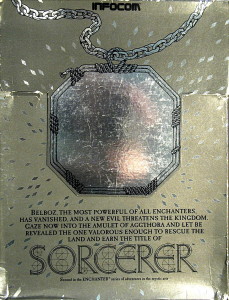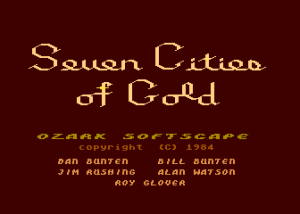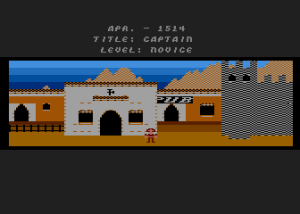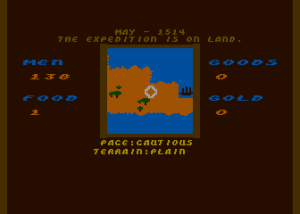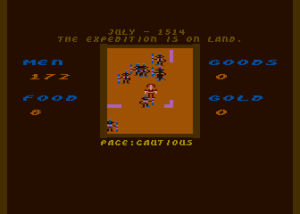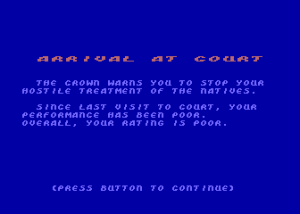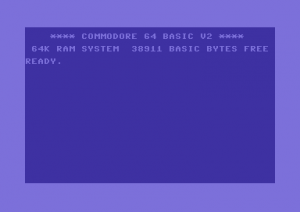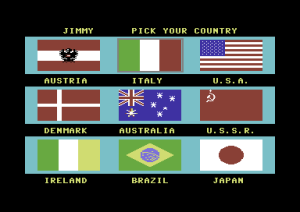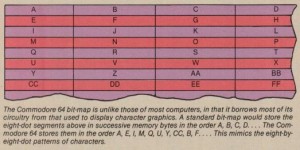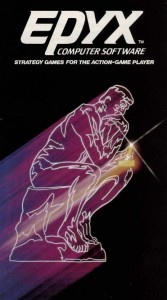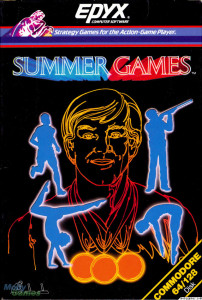Steve Meretzky was a boundless fount of creative energy which couldn’t be contained by even his official projects for Infocom, many and varied as they were, and spilled over into daily life around the office in the form of elaborate themed parties, games that ranged from a multiplayer networked version of Boggle played over the DEC minicomputer to intense Diplomacy campaigns, and endless practical jokes. (“Memo hacking” became a particular favorite as Business Products ramped up and more and more buttoned-down business types started to appear in the office.) The lore and legends of daily life at Infocom, eagerly devoured by the faithful via the New Zork Times newsletter, is largely the lore and legends of Steve Meretzky, instigator and ringleader behind so much of the inspired lunacy.
Yet there was also another, oddly left-brained side to Meretzky. He was a compulsive organizer and even a bit of a neat freak; his meticulous and breathtakingly thorough archives informed much of Jason Scott’s Get Lamp project and, by extension, much of the Infocom history on this site. Mike Dornbrook, Infocom’s marketing director, calls Meretzky the most productive creative person he has ever met, one who evinced not a trace of the existential angst that normally accompanies the artistic temperament. Writer’s block was absolutely unknown to him; he could just “turn it on” and pour out work, regardless of what was happening around him or how things stood in his personal life.
But there was still another trait that made Meretzky the dream employee of any manager of creative types: he was literally just happy to be at Infocom, thrilled to be out of a career in construction management and happy to work on whatever project needed him. And so when Dave Lebling decided he’d like to write a mystery game and Marc Blank wanted to work on technology development, leaving the critical second game in the Enchanter trilogy without an author, Meretzky cheerfully agreed to take it on. When a certain famous but mercurial and intimidating author of science-fiction comedies came calling and everyone else shied away from collaborating with him, Meretzky said sure, sounds like fun. And when Tor Books offered Infocom the chance to make a series of Zork books in the mold of the absurdly successful Choose Your Own Adventure line, and everyone on the creative staff turned up their noses at such a lowbrow project even as management rubbed their hands in glee at the dollar figures involved, Meretzky took the whole series on as his moonlighting gig, cranking out four books that were hardly great literature but were better than they needed to be. Most gratifyingly of all, Meretzky ripped through all of these projects in a bare fifteen months whilst offering advice and ideas for other projects and, yes, getting up to all that craziness that New Zork Times readers came to know and cherish. Meretzky was truly a dream employee — and a dream colleague. One senses that if management had asked him to go back to testing after finishing Planetfall he would have just smiled and kicked ass at it.
Sorcerer, his sequel to Enchanter and Infocom’s first game of 1984, was, like so much of Meretzky’s work in this period, a bit of a thankless task. He neither got to devise the overarching plot and mechanics for the trilogy nor to bring things to a real conclusion, merely to write the bridge between fresh beginning and grand climax. Middle works in trilogies have always tended to be problematic for this very reason, and, indeed, Sorcerer is generally the most lightly regarded of the Enchanter games. I won’t really argue with that opinion, but I will say that Sorcerer is a very solid, entertaining work in its own right. It’s just that it gets a bit overshadowed by its towering companions, together arguably the best purely traditional adventure games ever to come out of Infocom, while also lacking the literary and thematic innovations that make games like Planetfall and Infidel — to neither of which it’s actually markedly inferior in overall quality — so interesting for people like me to write about.
Sorcerer casts you as the same budding enchanter you played in the game of that name. Having vanquished Krill, however, your star has risen considerably; you are now a member of magic’s innermost circle, the Circle of Enchanters, and protege of the Leader of the Circle, Belboz. Sorcerer opens with one of its most indelibly Meretzkian sequences. You are snug in your bed inside the Guild of Enchanters — but you don’t actually realize that for a few turns.
You are in a strange location, but you cannot remember how you got here. Everything is hazy, as though viewed through a gauze...
Twisted Forest
You are on a path through a blighted forest. The trees are sickly, and there is no undergrowth at all. One tree here looks climbable. The path, which ends here, continues to the northeast.
A hellhound is racing straight toward you, its open jaws displaying rows of razor-sharp teeth.
>climb tree
Tree Branch
You are on a large gnarled branch of an old and twisted tree.
A giant boa constrictor is slithering along the branch toward you!
The hellhound leaps madly about the base of the tree, gnashing its jaws.
>i
You are empty-handed.
The snake begins wrapping itself around your torso, squeezing the life out of you...
...and a moment later you wake up in a cold sweat and realize you've been dreaming.
SORCERER: INTERLOGIC Fantasy
Copyright (c) 1984 by Infocom, Inc. All rights reserved.
SORCERER and INTERLOGIC are trademarks of Infocom, Inc.
Release 4 / Serial number 840131
Your frotz spell seems to have worn off during the night, and it is now pitch black.
Like the similarly dynamic openings of Starcross and Planetfall, albeit on a more modest scale, Sorcerer‘s dream sequence can be a bit of a misnomer. The rest of the game is much more open-ended and much less plot-driven than this sequence might imply. As you explore the conveniently deserted Guild — everyone except you and Belboz have gone into town to shop for the Guild picnic — you soon realize that Belboz has mysteriously disappeared. And so the game is on, fueled by the same sort of magic-based puzzles that served Enchanter so well. Indeed, Meretzky copied the code for the Enchanter magic system wholesale into Sorcerer, along with some of the same spells, which had to be a great help for someone working on as tight a timetable as he was. Sorcerer‘s one big magical innovation is a set of potions to accompany its spell scrolls, something notably absent not only from Enchanter but also from Lebling’s Spellbreaker, the final game of the trilogy.
Like all of the Enchanter trilogy a very traditional game, Sorcerer is divided into two open-ended areas of exploration, the Guild of Enchanters and a sprawling wilderness and underground map which ultimately proves to house Belboz’s abductor, the demon Jeearr (another thoroughly Meretzkian name, and a character who also turns up in the last of the Zork gamebooks he was writing at the same time). The overall feel is looser than Enchanter, with the first game’s understated humor replaced with a more gonzo sensibility that can rub some players the wrong way. This player, who felt that Planetfall often seemed to be trying just a bit too hard, doesn’t exactly find Sorcerer hilarious but never really found it irritating in the way that Meretzky’s earlier game could occasionally be either. Perhaps the fact that Sorcerer wasn’t explicitly billed as a comedy left Meretzky feeling freer not to force the issue at every possible juncture.
Another Planetfall trait, that of lots of Easter eggs and red herrings, is also notable in Sorcerer, but again to a lesser extent. The useless bits, such as a functioning log flume and roller coaster inside the amusement park inexplicably located almost next door to Jeearr’s infernal lair, are mostly good fun. The sadomasochistic “potion of exquisite torture” is a standout that is just a bit risque for the prudish world of adventure gaming:
>drink indigo potion
The potion tastes like a combination of anchovies, prune juice, and garlic powder. As you finish swallowing the potion, a well-muscled troll saunters in. He whacks your head with a wooden two-by-four, grunting "You are playing Sorcerer. It was written by S. Eric Meretzky. You will have fun and enjoy yourself." He repeats this action 999 more times, then vanishes without a trace.
Another great bit comes if you use the aimfiz spell — “transport caster to someone else’s location” — to try to find Meretzky himself:
>cast aimfiz on meretzky
As you cast the spell, the moldy scroll vanishes!
You appear on a road in a far-off province called Cambridge. As you begin choking on the polluted air, a mugger stabs you in the back with a knife. A moment later, a wild-eyed motorist plows over you.
**** You have died ****
Like any old-school adventure game, Sorcerer is full of goofy and often random ways to die, from wandering into a room that’s missing a floor to getting buried under coins by an overenthusiastic slot machine. Still, Meretzky manages to skirt the letter if not quite the spirit of Andrew Plotkin’s Cruelty Scale through the gaspar spell: “provide for your own resurrection.” Gaspar returns you upon your death alive and well to the place where you last cast it, a handy substitute for the technological rather than arcane solution of restoring a saved game. If nothing else, its presence proves that Infocom was thinking about the arbitrary cruelty of most adventure games and wondering if a friendlier approach might be possible. (Space limitations would, however, always limit how far they could travel down this path. It would always be easier to simply kill the player than try to implement the full consequences of a bad — or simply unplanned for — decision.) Another sign of evolving thought on design comes in the form of the berzio potion (“obviate need for food or drink”), which slyly lets you bid adieu to the hunger and thirst timers of Enchanter and Planetfall. A year later, Spellbreaker would not even bother you with the whole tedious concept at all.
As the presence of amusement parks and casinos next to abducted enchanters and demons would imply, Sorcerer doesn’t concern itself at all with the fictional consistency that marked Planetfall or even, for that matter, Enchanter. Plot also takes a back seat for most of the game. You simply explore and solve puzzles until you suddenly bump into Jeearr and remember why you’re here. Likewise, some of the writing is a bit perfunctory if we insist on viewing Sorcerer as a literary experience. That, however, is not its real strength.
I find Meretzky slightly overrated as a writer but considerably underrated as a master of interlocking puzzle design. Sorcerer is full of clever puzzles, one of which, a relatively small part of the brilliant time-travel sequence in the coal mine, represents the last little bit of content which Infocom salvaged from the remaining scraps of the original MIT Zork. Yet it isn’t even one of the most memorable puzzles in Sorcerer; those are all Meretzky originals. In addition to that superb time-travel puzzle, there’s a fascinating thing that seems to be a maze but isn’t — quite. Both time-travel puzzles and pseudo-mazes were already burgeoning traditions at Infocom; both would remain obsessions of the Imps for years to come. Meretzky does both traditions proud here. I won’t say too much more about Sorcerer‘s puzzles simply because you really should enjoy them for yourself if you haven’t already. They’re always entertaining, clever, and (sudden deaths and one tricky sequence involving a timed mail delivery early in the game aside) fair, and don’t deserve to be spoiled by the likes of me.
Sorcerer shipped in March of 1984 in a box that was fairly plebeian for this era of Infocom. The crown jewel was contained inside the box this time, in the form of the infotater, an elaborately illustrated code wheel that was both one of Infocom’s most blatant uses yet of a feely as unabashed copy protection and so cool that it didn’t really matter. The infotater is today among the rarer pieces of Infocom ephemera. It remained in production for just a few months before Infocom switched to a standardized box format that was too small to accommodate it, and were thus forced to replace it with a less interesting table of information on plain paper.
Sorcerer sold decently, although not quite as well as Enchanter or the Zork games. (The steady downward trend in sales of Infocom’s flagship line of fantasy games would soon become a matter of increasing concern — but more on that in future articles.) Lifetime sales would end up in the vicinity of 45,000, with more than two-thirds of those coming in 1984 alone. It’s not one of the more ambitious games of Infocom nor, truth be told, one of the absolute best, but it is a solid, occasionally charming, playable game. If you find yourself in the mood for an enjoyable traditional text adventure that plays relatively fair with you, you could certainly do a lot worse.
(As always, thanks to Jason Scott for sharing his materials from the Get Lamp project.)
